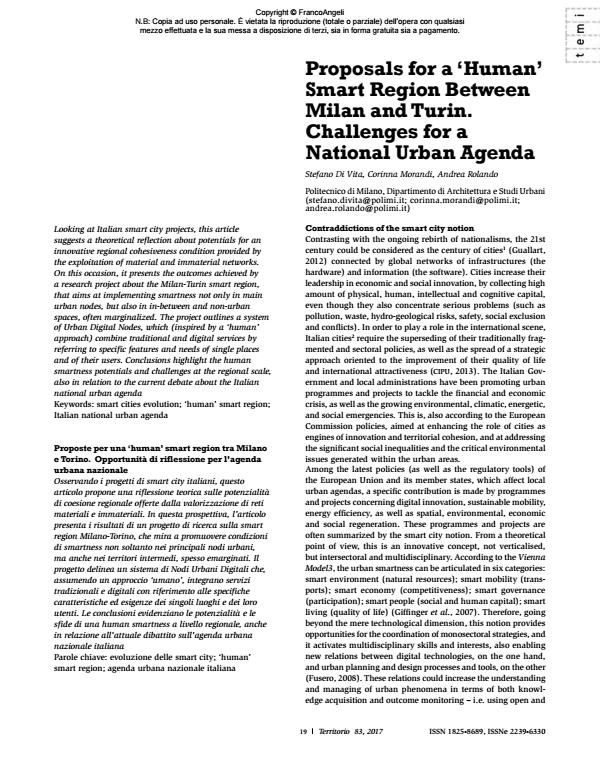Proposals for a ‘Human’ Smart Region Between Milan and Turin. Challenges for a National Urban Agenda
Titolo Rivista TERRITORIO
Autori/Curatori Stefano Di Vita, Corinna Morandi, Andrea Rolando
Anno di pubblicazione 2018 Fascicolo 2017/83
Lingua Inglese Numero pagine 13 P. 19-31 Dimensione file 440 KB
DOI 10.3280/TR2017-083003
Il DOI è il codice a barre della proprietà intellettuale: per saperne di più
clicca qui
Qui sotto puoi vedere in anteprima la prima pagina di questo articolo.
Se questo articolo ti interessa, lo puoi acquistare (e scaricare in formato pdf) seguendo le facili indicazioni per acquistare il download credit. Acquista Download Credits per scaricare questo Articolo in formato PDF

FrancoAngeli è membro della Publishers International Linking Association, Inc (PILA)associazione indipendente e non profit per facilitare (attraverso i servizi tecnologici implementati da CrossRef.org) l’accesso degli studiosi ai contenuti digitali nelle pubblicazioni professionali e scientifiche
Looking at Italian smart city projects, this article suggests a theoretical reflection about potentials for an innovative regional cohesiveness condition provided by the exploitation of material and immaterial networks. On this occasion, it presents the outcomes achieved by a research project about the Milan-Turin smart region, that aims at implementing smartness not only in main urban nodes, but also in in-between and non-urban spaces, often marginalized. The project outlines a system of Urban Digital Nodes, which (inspired by a ‘human’ a roach) combine traditional and digital services by referring to specific features and needs of single places and of their users. Conclusions highlight the human smartness potentials and challenges at the regional scale, also in relation to the current debate about the Italian national urban agenda
Osservando i progetti di smart city italiani, questo articolo propone una riflessione teorica sulle potenzialità di coesione regionale offerte dalla valorizzazione di reti materiali e immateriali. In questa prospettiva, l’articolo presenta i risultati di un progetto di ricerca sulla smart region Milano-Torino, che mira a promuovere condizioni di smartness non soltanto nei principali nodi urbani, ma anche nei territori intermedi, spesso emarginati. Il progetto delinea un sistema di Nodi Urbani Digitali che, assumendo un approccio ‘umano’, integrano servizi tradizionali e digitali con riferimento alle specifiche caratteristiche ed esigenze dei singoli luoghi e dei loro utenti. Le conclusioni evidenziano le potenzialità e le sfide di una human smartness a livello regionale, anche in relazione all'attuale dibattito sull'agenda urbana nazionale italiana
Parole chiave:Evoluzione delle smart city; ‘human’ smart region; agenda urbana nazionale itali
Stefano Di Vita, Corinna Morandi, Andrea Rolando, Proposals for a ‘Human’ Smart Region Between Milan and Turin. Challenges for a National Urban Agenda in "TERRITORIO" 83/2017, pp 19-31, DOI: 10.3280/TR2017-083003